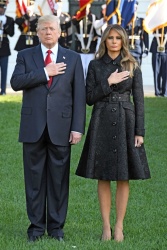Melania Trump Wears Dolce & Gabbana to Donate Her Inaugural Ball Dress at the Smithsonian
Melania Trump donated her Inaugural ball dress today at the Smithsonian, a tradition carried out by First Ladies for over a century. For the occasion, Trump went with a familiar name, Dolce & Gabbana, instead of a custom piece from the piece's designer Hervé Pierre, though he was also on hand for the celebration. “This means everything to me,” said Pierre via email ahead of the event. “I will have contributed, in part, to a small piece of American history!” That sentiment was echoed by Dr. David Skorton, the current Secretary of the Smithsonian, who was taking part in his first First Lady ceremony today. “This is one of those destination areas that people really want to see,” said Skorton of the museum’s First Ladies collection, an ongoing exhibition which features the looks worn by Frances Cleveland, Lou Hoover, Jacqueline Kennedy, Laura Bush, Michelle Obama, and more. “The reverence for First Ladies, the work that so many First Ladies have done in fields broad and deep, along with an very abiding interest in fashion; it’s an intersection of those elements that bring people in such large numbers.” Trump’s ensemble for the ceremony, a streamlined white dress with coordinating Manolo Blahnik stilettos, was appropriate and reserved with a fashion-minded twist—not unlike the Inaugural dress itself.
“We have the same vocabulary,” explained Pierre of that dress’s creation. “I could understand what she had in mind; the process was easy because the First Lady knows fashion.” And while Skorton refused to name his favorite from the lot—“I love all my children, so to speak!”—he did reveal that Trump’s dress allowed him to learn a thing or two about fashion. “The gown is very, very interesting,” said Skorton. “The curator was trying to explain to me all the nuances of the color white."
Pierre, too, is happy visitors will have the opportunity to experience the design up close: “I am so pleased everyone will be able to see the dress and the real textures that television doesn’t really give you." For those unable to make the trip, Skorton and his team at the Smithsonian have been digitizing the archive, though Skorton concedes that there is a distinct magic to seeing the pieces in real life. “What I’m struck with is how seeing the gown triggers my memory of that time and the things that happened in our country at that time,” he said. "To understand the link between the way our society is changing, the way women’s role in society is recognized, and the way fashion casts some light on that, that idea is really, really fascinating.”




































